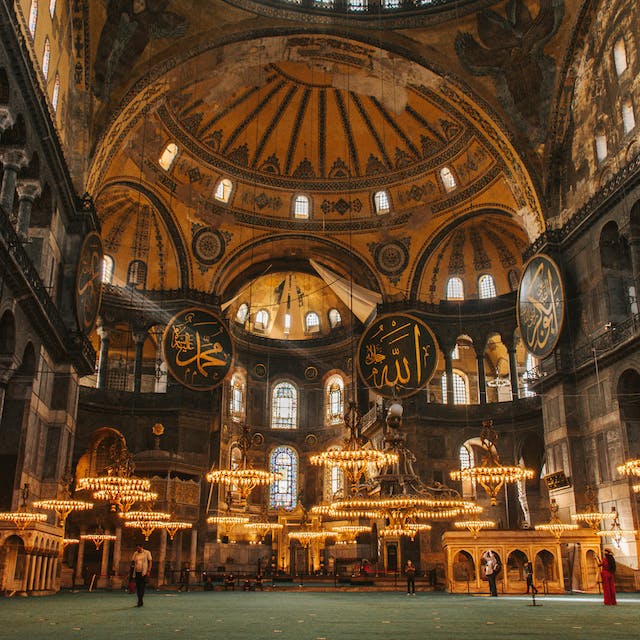Background
The Hagia Sophia, whose name translates to “holy wisdom,” is a domical structure that was first erected as a cathedral in Constantinople (currently Istanbul, Turkey), in the sixth century A.D. It has two levels and is centered on a huge nave with smaller domes towering above and a large dome over it. It has been a cathedral, a mosque, and most recently a museum during its 1,400-year existence. Constantinople served as the Byzantine Empire’s capital when it was first built. Originally constituting the eastern half of the Roman Empire, this state—which was formally Christian—persisted after the fall of Rome.
A Brief History of the Hagia Sophia
First Construction
When Istanbul was known as Constantinople and served as the seat of the Byzantine Empire, Constantius the Great gave the Hagia Sophia its initial commission in 360 CE. Since the Greek Orthodox Church was the Byzantine Empire’s official religion, the first Hagia Sophia was constructed. When political unrest erupted in Constantinople in 404 CE, the first Hagia Sophia church was completely destroyed.
Second Construction
Theodosius II, the Roman emperor, reconstructed the Hagia Sophia in 415 CE, and during the Nika riots, it burned down once more. The riot began in the hippodrome between the blue and green chariot racing factions, and it quickly spread across the city. The rioters shouted “Nika,” which means “victory,” and they tried to overthrow Justinian by besieging him in his palace. People wanted Justinian to leave power because of the enormous taxes he had levied. After sending devoted soldiers into the city, Justinian was able to crush the uprising by force.
Third Construction
Byzantine Emperor Justinian I hired the architects Isidore of Miletus and Anthemius of Tralles to construct the new church, which was completed in 537 CE.
Fourth Crusade
Constantinople briefly came under the rule of the Latin Empire during the Fourth Crusade, and the Hagia Sophia was robbed.
Istanbul
When the Ottoman Empire under Sultan Mehmed II (also known as Mehmet the Conqueror) conquered Constantinople in 1453, the Hagia Sophia experienced a number of substantial renovations. The primary religion changed from Christianity to Islam, and the Hagia Sophia was refurbished to become an imperial mosque. The city was renamed Istanbul.
Remodel
The Hagia Sophia began to deteriorate during Selim II’s rule (1566–1574). The structure was strengthened by the work of Ottoman architect Mimar Sinan, who also constructed buttresses, two more minarets, a sultan’s lodge, and a mausoleum for Selim II.
Transformation
Many of the original Christian mosaics, including one of Jesus Christ on the central dome, were covered in Islamic calligraphy after the Ottoman takeover, which was created by Kazasker Mustafa zzet. In a wall facing Mecca, a mihrab—a prayer niche—was erected, and four new minarets were constructed.
Twentieth Century
The edifice was secularized in 1934 by Kemal Atatürk, the first leader of the Turkish Republic. The Hagia Sophia was included in the Historic Areas of Istanbul, a group of structures, when it was named a UNESCO World Heritage site component in 1985. The Hagia Sophia Museum was run by the Ministry of Culture until 2020.
Mosque
The Hagia Sophia was reclassified as a mosque in July 2020, and prayer services were once again held there under the authority of the Turkish Council of State and Turkish President Recep Tayyip Erdoan.
Architectural Style of the Hagia Sophia

The domed ceiling of the Hagia Sophia rises 180 feet above the ground, and it is 269 feet long and 240 feet wide. It is the most prominent surviving example of Byzantine architecture and was constructed in the grand Christian Basilica style. The building’s significant features are discussed here.
Building Materials
The basilica was built with resources from every province because Emperor Justinian intended it to be a symbol of the whole Byzantine Empire. While the bricks for the walls and a portion of the floor came from North Africa, the marble for the floor was made in Anatolia, which is present-day eastern Turkey and Syria.
Floor Plan
The structure virtually has a square plan. It has three aisles with columns separating them, each with a mosaic gallery. Forty windows are located above the galleries, giving the sense that the roof is floating.
Columns
There are 104 columns in the Hagia Sophia, many of which were transported from Egypt and the Temple of Artemis at Ephesus, an ancient city close to Selçuk, Turkey.
Dome
The main nave is covered by a 107-foot-diameter dome that rises 180 feet above the floor. One of the first extensive uses of pendentives is the support of the dome by four of them. After St. Peter’s Basilica in Rome, the Hagia Sophia has the second-largest pendentive dome in the entire globe. At the altar and the main entrance, respectively, there are two semi-domes on either side.
Mosaics
Christians decorated the ancient Hagia Sophia with frescoes and mosaics. The Ottoman Turks painted over a large number of the old Christian artworks. A prominent mosaic that still exists in the Hagia Sophia depicts the Virgin Mary holding the young Jesus in her arms against a background of gold mosaics. A mosaic of the Virgin Mary, Emperor Constantine, the first emperor of the Byzantine Empire, and Emperor Justinian I may be found above the southwest entrance to the Hagia Sophia.
Conclusion
An ancient house of worship, the Hagia Sophia, may be found in Istanbul, Turkey, in Eastern Europe. The Hagia Sophia is known by several titles, including “Holy Wisdom” or “Divine Wisdom” in English, “Sancta Sophia” in Latin, and “Ayasofya” in Turkish. As an Orthodox Christian Church for the Byzantine Empire, also known as the Eastern Roman Empire or Byzantium, the existing building was constructed in the sixth century. In the Sultanahmet area of the Fatih district, the Hagia Sophia is currently one of the most popular tourist destinations in Turkey. The Basilica Cistern and the Topkap Palace are nearby, and it is directly across the street from the Blue Mosque.

